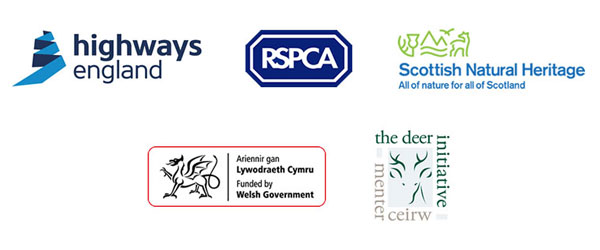
Drivers warned to look out for deer roaming on to the country’s roads and posing risks to road users
04/10/19|
Drivers are today being warned to look out for deer roaming on to the country’s roads and posing risks to road users. The warning comes with more deer on the move during the rutting season. At this time of year, deer collisions peak as many of the animals cross roads seeking new territories. The highest risk of collisions is between sunset and midnight, and the hours shortly before and after sunrise.
Someone who knows only too well what it is like to be involved in a collision with deer is Aaron Herringshaw.
Aaron, a chef from Bournemouth with a regular commute across rural Dorset, said: “I know what the consequences are and the literal impact of a collision with a deer having been unfortunate enough to experience two incidents in eighteen months. Both collisions were really distressing and resulted in my car being written off, which takes time to sort out and means my insurance has gone up, but I am thankful that no-one got hurt.
“Both incidents happened during my early morning drive to work at around 5.30am on roads that I know well and travel on frequently. I am aware of the wildlife in the area and weather-wise it was clear but both times a deer leapt out of the hedge in right front of my car with absolutely no warning. The impact is quite scary as you have no control of the vehicle in that split second - it is somewhat surreal because you’re not expecting that to happen first thing in the morning.”
Caption: Driver Aaron Herringshaw. For hi-res image click here
He continues: “I have always considered myself to be a safe and careful driver – if it happens to me it could happen to anyone. I have changed my driving style to be even more vigilant and I am always on the look-out for deer warning signs. You don’t know when or how a collision could occur – the deer warning signs are there for a reason. They give you that extra bit of information that wildlife is in the area and to slow down and be extra cautious.”
So today The Deer Initiative and Highways England have teamed up to back up the advice to drivers.
Leonardo Gubert, Senior Ecologist at Highways England, the Government company responsible for motorways and major A roads in England, said: “You may be well-travelled and on a well-known route without ever seeing a deer before, but there may be one hidden in nearby foliage or woodlands and some species of deer can often gather in large groups; you may have seen one and avoided it but others may follow and unexpectedly dart out into the roadway. You may have also seen deer signs at locations where you have never spotted deer but the fact is that they have been installed in areas with high deer numbers and their purpose is to alert drivers that there is a higher possibility of encountering them along that particular stretch of road.
“We want everyone travelling on our roads to reach their destination safely and with as many as 1.5 million wild deer living across Britain it is vital for drivers to be aware of their presence, to be extra vigilant, especially at this time of year when deer are on the move.”
Deer signs are placed at locations where the animals are known to be active and are likely to cross; they help inform drivers of the need to slow down to give more time to react.
David Jam, Director of The Deer Initiative said: “Whilst deer are a constant risk to drivers, they are especially active during Autumn and Spring, especially at dusk and dawn. To stay as safe as possible on the roads, please take note of the following advice:
“After dark, do use full-beams when there is no opposing traffic: the headlight beam will illuminate the eyes of deer on or near a roadway and provide greater driver reaction time; BUT, when a deer is seen on the road, dim your headlights as when startled by the beam they may ‘freeze’ rather than leaving the road.
“When approaching deer warning signs, drivers should slow down and be prepared to stop.” Figures collated from several studies suggest that while it is safe to say 40,000 deer are killed in vehicle collisions every year, this ?figure could be as high as 74,000 ?across Britain. Conservative estimates of 400 injuries to motorists and passengers related to these collisions ?could in fact be nearer 1000 annually with up to 20 fatalities per year.
Accurate records of deer-vehicle collisions are vital as they help build an accurate picture of the roads most at risk of deer collision which can then be assessed, and appropriate measures to tackle the issue can be put in place. Drivers are urged to report any incidents via the Deer Aware website (www.deeraware.com).
Highways England works with partners including the Deer Initiative to identify deer-related collision ‘hotspots’ and to take appropriate measures to reduce the risk, including installing deer proof fencing and constructing larger culverts which provide an alternative route for deer to cross the road. If you hit a deer while driving, your priorities in this order are:
Caption: Aaron's car following a collision with a deer. For hi-res image click here Caption: Damage caused to Aaron's other vehicle after a deer collision. For hi-res image click here To report a deer vehicle collision or to find out more on safety ?advice?visit www.deeraware.com |
|
|
Ends |
|
|
NOTES TO EDITORS The Deer Initiative? The Deer Initiative is a broad partnership of statutory, voluntary and private sector interests dedicated to ‘ensuring the delivery of a sustainable wild deer population in England and Wales.’? ?For further ?information please ?contact?[email protected]? Highways England? Highways England is the government owned company responsible for managing, operating and modernising?England’s motorways and major A roads.? ?For further information please contact Highways England’s press office: 0844 693 1448 or email [email protected]? For further advice on driving on country roads please see link to THINK:?http://think.direct.gov.uk/country-roads.html Deer Aware?? ?Road traffic accidents involving deer present a major problem in the UK as well as in many other countries in Europe. For example, in Germany over 220,000 traffic collisions occur annually involving deer, over 1000 of which lead to human injuries and around 20 human fatalities.? In the UK there is no system for central collation of road traffic accidents involving deer or other wildlife, and firm statistics on the scale of the problem in this country remain unavailable.? However, a pilot survey commissioned by the then Highways Agency?(now Highways England)?in 1997 based on retrospective data estimated that the number of?deer?killed annually in traffic collisions in the UK was already between 30,000 and 40,000.? ?A fuller study started in 2003, again with lead funding from the then Highways Agency (now Highways England), based on sample data collected annually from a range of organisations and individuals; this reaffirms that the annual number of?deer?killed or injured on UK roads is likely to exceed 40,000 and may well be nearer 74,000. Further information on the findings of the studies available at:?http://www.deercollisions.co.uk/ftp/DI%20England%20Monitoring%20DVCs%20to%202010/DI-DVC_England2011_Summwfigs_rev.pdf? Real-time traffic information for England’s motorways and major A roads is available via its website (www.trafficengland.com), local and national radio travel bulletins, electronic road signs and mobile apps. Local Twitter services are also available at https://highwaysengland.co.uk/highways-england-about-us. |
|
|
|
|
|
Option 1: National enquiries (9am to 5.30pm) & out of hours for urgent enquiries |





